#Chūshingura
Photo
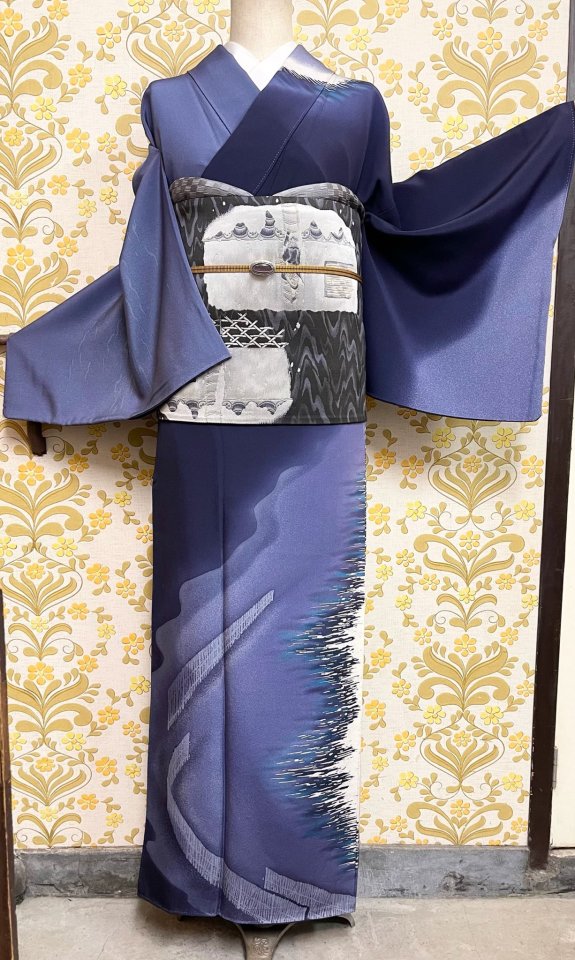



Refined colors for this muted outfit, pairing a soothing kimono depicting a beach and moonlit sea, paired with an unusual obi with people scaling walls on bamboo ladders.
The obi is a nod to an episode of the famous Forty-seven ronin narrative, where the loyal ronin after months of careful planning, attack the mansion of their ennemy Kira Yoshinaka (Moronao in Chushingura plays) to assassinate him in the dead of night.
#japan#fashion#kimono#obi#sea#moonlit sea#47 ronin#Forty-seven ronin#akoroshi#赤穂浪士#Shijūshichishi#四十七士#Chūshingura#忠臣蔵#The Treasury of Loyal Retainers#samurai#ronin#着物#帯
149 notes
·
View notes
Text
Love this long take from The 47 Ronin/Genroku Chūshingura a lot. Simple but captivating 🖤
Dir. Kenji Mizoguchi
#love these takes and camera movements a lot...#The 47 Ronin#the 47 ronin 1941#Genroku Chūshingura#元禄 忠臣蔵#kenji mizoguchi#cinema#japanese cinema#jidaigeki#video
0 notes
Photo

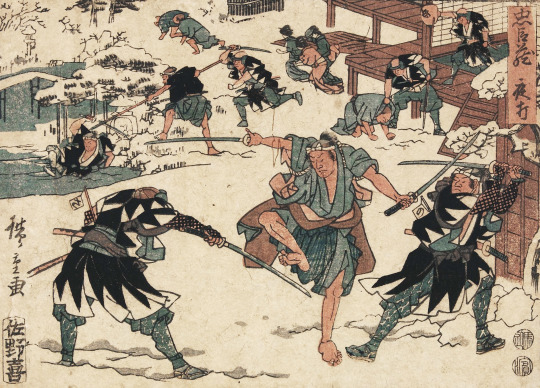
UTAGAWA HIROSHIGE's The Storehouse of Loyal Retainers
(Chūshingura)
Date: 1847-52
288 notes
·
View notes
Photo

That’s TAKARAZUKA 2023 Flower Troupe
LOOK BACK on 2022 – You can feel their resilience and strength after overcoming the tribulations.

(The performance is Genroku. The Mizu Sumitomo Visa Card Theatre Musical “Genroku Baroque Rock” is full of glamorous costumes.)
From January, Yuzuka-san and Hoshikaze Madoka-san became the new Top Combi and started Flower Troupe’s 2022, going through a turbulent year. The year began with the Tokyo Takarazuka Theatre performance – a story of Chūshingura added with time traveling elements “Genroku Baroque Rock” and the show celebrating Flower Troupe’s 100th anniversary “The Fascination! – Flower Troupe’s 100th Anniversary To The Future and Beyond–”. But it was forced to stop right after it started and even though it reopened later, it was ultimately a performance period of 12 days.

(Yuzuka-san was what people discussed a lot, as she not only played the beautiful pianist Liszt in “Years of Pilgrimage” but also for actually performing the piano live.)
In the next Grand Theatre performance, it is the musical portraying the life of the piano magician Liszt “Years of Pilgrimage~The Wandering Soul of Liszt Ferenc” and the stylish show “Fashionable Empire”. In the Tokyo performances also, the first day opened a few days later but it was announced that there were suspensions again and the performance reopened only on the last day (Senshuuraku). But the Senshuuraku performance was the thing to believe that it’s not just about feeling negative – I believe that was what the Flower Troupe members were thinking on the day. That it was a stage that’s not too forceful, but sincere and passionate; that it’s enriching with precision rather than leaving a blank. Especially the thing that caught my eye was how powerful the group dances were. That’s how strong the resilience of the troupe is, with Top Star Yuzuka-san in the centre. We are looking forward to Flower Troupe in 2023 as they accumulate and become a level stronger in resilience.
Q: What kind of troupe is Flower Troupe?
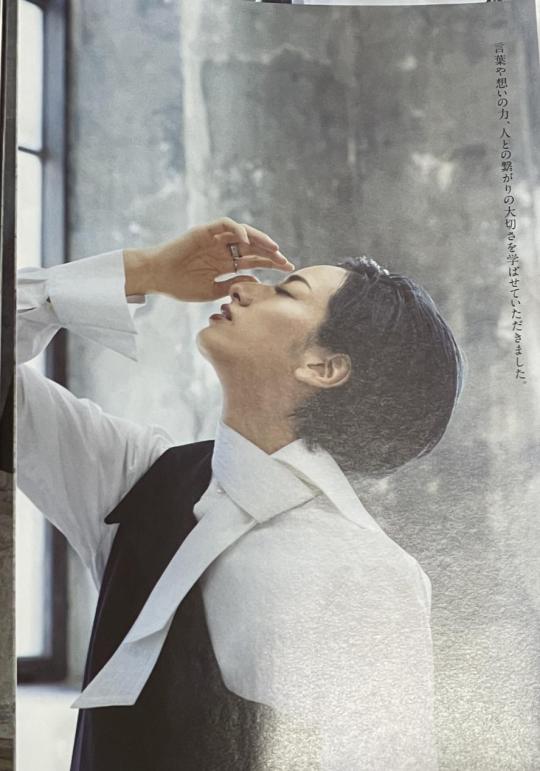
From Yuzuka-san:
Everyone is cheerful and bright and are wonderful kids that are moving forward enthusiastically. I’m thankful for them. Their energy in rehearsals are amazing, and I’m happy they can perform on stage with such liveliness and vividness. From now on, I’d be thankful that everyone could always be professional and aspire to improve, being a troupe that is honing and improving.

From Minami-san:
They’re very bright and I feel that everyone including the underclassmen have their own objectives and are progressing towards then. They have a passion for the performing arts. The underclassmen are always learning from the upperclassmen. The upperclassmen would also be the first in position ready to teach them, and when I see that every time, I’d think this is a good troupe.
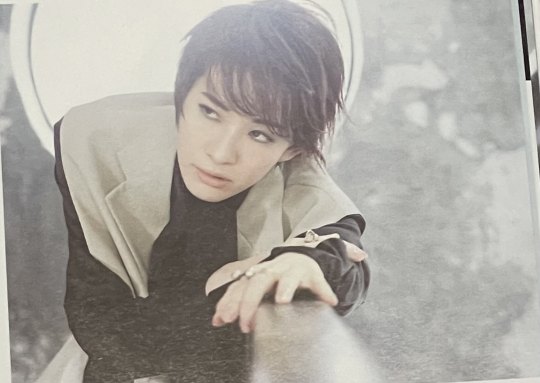
From Towaki-san:
We’re a troupe that’s often growing and expanding to be better. That otokoyaku and musumeyaku are all enjoying to focus on the key points of being otokoyaku and musumeyaku and I feel that we respect each other.
Q: What kind of person is Hoshikaze Madoka-san?
From Yuzuka-san:
I’ve been thinking of this ever since we’re a combi, but she’s quick at understanding what I want to do. I am truly grateful for her being straightforward, playful and ambitious and she enjoys the process of transforming with me. It's been about a year and a half since we started working together, but I feel like we'll be together even longer.
NEXT STAGE – This is the Takarazuka CLASSIC. A classical performance portrayed in Reiwa (year).
Flower Troupe is starting January in the Takarazuka Grand Theatre with the two-set show of “MAYERLING” and “ENCHANTEMENT–A Luxurious Perfume–”. “MAYERLING” portrays the historical story of the misfortunate Austria Crown Prince Rudolf as the protagonist, a masterpiece performed again ever since the premiere in 1983. The one who wrote the script, Shibata Yukihiro-san was a longtime playwright and director of Takarazuka Revue ever since the ‘60s. Yuzuka-san led Flower Troupe to perform “Sorrowful Cordoba” in 2021, “Love Burns in Firenze” in 2022 for the national tour performances. The Shibata works have a classical depth to it and when they were performed by Yuzuka-san who’s modern and stylish, she adds smartness and reality to the melodrama. Yuzuka-san played Rudolf once in “Elisabeth – The Rondo of Love and Death”, and she enjoys it very much to pursue the portrayal of the ultimate love. At the same time “ENCHANTEMENT” is a show with perfume as a theme. From the title, it is a word meaning “magical” and “rapture”. It’s a performance that is sometimes sweet, sometimes spicy and exotic, one that is gorgeously charming.
Q: Please tell us about your favourite scents.

From Yuzuka-san:
I love citrus smells when I’m in underclassmen times…recently I like something that’s a little stronger and deeper…compared to flower aromas, I like scents that are sweet like vanilla more. Also, when I clean the room, I open the window for a refresh of air, I love to light some aroma scented (candles) in the room.

From Minami-san:
I like the citrus and fresh kind of scents. I'm actually very sensitive to smell, so if it’s car refresher or car perfumes, I don’t like those with strong synthetic smell. I think scents I like can affect those around me, so I’ve been using perfumes a lot these years. Recently I like the laundry smell the most.

From Towaki-san:
Even though I like almost all kinds of good scents, recently among those scents, I like those with smoky aroma. That’s why instead of aroma candles, I’m the kind that likes the charcoal or incense smell. Recently, my favourite is using a spicy or smoky kind of spray type to fill the room with fragrance.
(Admin’s note: This is the last of the ANAN Translation series! 💙)
#yuzuka rei#hoshikaze madoka#minami maito#towaki sea#flower troupe#takarazuka#takarazuka revue#hibiscustranslation#柚香光#水美舞斗#永久輝せあ
56 notes
·
View notes
Text
Spotlight: The Ichiriki

On The Eleventh Day Of Fun I present... another ask! I’ve been holding onto this one for close to a year (sorry about that!), so let’s take a look at arguably the most famous ochaya in Japan!
The Ichiriki (一力亭) was first established in the 17th century in the heart of what would become Gion. It actually started out life as the Yorozuya (万屋), which just means “General Store.” Due to the popularity of the play Kanadehon Chūshingura (仮名手本忠臣蔵), who disguised the name as Ichiriki to get past censorship (breaking up the “万” kanji into “一” and “力”), the establishment actually renamed itself to the Ichiriki and has retained the name ever since.
The Chūshingura stories, also known as The Legend of The 47 Ronin, are what have cemented the Ichiriki into legend. It was at the Ichiriki that the leader of the 47 ronin, Oishi Kuranosuke (大石内蔵助) (1659 - 1703), plotted his revenge against the man who made their master commit suicide, Kira Yoshinaka. To celebrate the bravery of the 47 ronin, a dedication dance is held each year on March 20th in the main room of the Ichiriki called Oishi Ki (大石忌). The highlight is Yachiyo Inoue’s dance and one of the only times that she performs annually. This is an invite only event for the Ichiriki’s most loyal customers.
The family that owns and operates the Ichiriki is the Sugiura (杉浦) family. They are currently on the 9th head of the establishment, with Jirōuemon Sugiura being the current proprietor.
Image of the Ichiriki is courtesy of Jitbag.
34 notes
·
View notes
Text
Can you imagine being a Weaboo in the 1890's?
Like "oh have you seen the newest Kabuki Theater play Chūshingura (The Treasury of Loyal Retainers) ? "
Yo check out this Shamisen phonograph album!
8 notes
·
View notes
Text
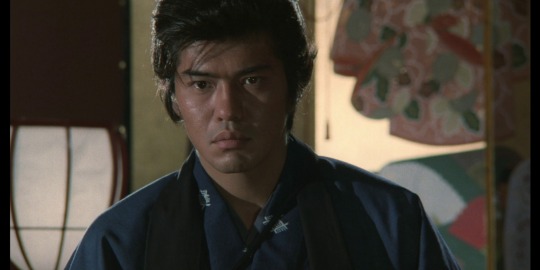
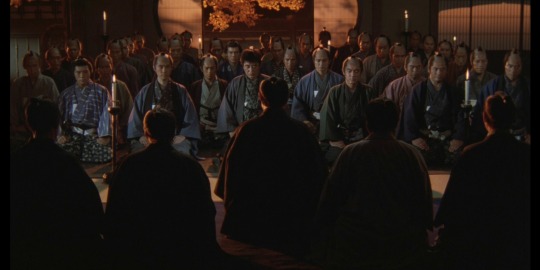


Crest of Betrayal, Chūshingura Gaiden: Yotsuya Kaidan, Kinji Fukasaku, 1994.
0 notes
Text
Embarking on a journey into the world of "Act Eight (Hachi danme)," you immediately sense the power of Kuniyoshi's artistry. Here, in this print, the viewer is met with a melange of emotions. The tension, the drama, the pulsating narrative — they all come to life as you delve deeper into the artwork.
"Act Eight (Hachi danme)" is part of Kuniyoshi's series, "Perspectives of the Eight Views," inspired by the classic Japanese play, Chūshingura. The series combines Kuniyoshi's expressive illustrations with tales from the popular play, giving birth to vibrant, intricate artworks that provoke thought and resonate with emotion.
Kuniyoshi's Act Eight, in particular, has been noted for its engaging narrative style and unique imagery, which reflect the unfolding drama of Chūshingura's tale of loyalty and honor.
#art#culture#art history#artwork#painter#painting#artblog#wall art#home decor#asian artist#asian culture#asian art#asian#japan#japanese artist#japanese culture#japanese art#japanese#utagawa kuniyoshi#kuniyoshi#act eight#hachi danme#act eight (hachi danme)#landscape#japanese landscape#asian landscape
0 notes
Text

Gen. Akashi Gidayu preparing to commit seppuku in Akashi Gidayu, print no. 83 in the Aspect of the Moon series by Yoshitoshi Tsukioka, c. 1890.
seppuku, (Japanese: “self-disembowelment”) also called hara-kiri, also spelled harakiri, the honourable method of taking one’s own life practiced by men of the samurai (military) class in feudal Japan. The word hara-kiri (literally, “belly-cutting”), though widely known to foreigners, is rarely used by Japanese, who prefer the term seppuku (written in Japanese with the same two Chinese characters but in reverse order).
The proper method for committing the act—developed over several centuries—was to plunge a short sword into the left side of the abdomen, draw the blade laterally across to the right, and then turn it upward. It was considered exemplary form to stab again below the sternum and press downward across the first cut and then to pierce one’s throat. Being an extremely painful and slow means of suicide, it was favoured under Bushidō (warrior code) as an effective way to demonstrate the courage, self-control, and strong resolve of the samurai and to prove sincerity of purpose. Women of the samurai class also committed ritual suicide, called jigai, but, instead of slicing the abdomen, they slashed their throats with a short sword or dagger.
There were two forms of seppuku: voluntary and obligatory. Voluntary seppuku evolved during the wars of the 12th century as a method of suicide used frequently by warriors who, defeated in battle, chose to avoid the dishonour of falling into the hands of the enemy. Occasionally, a samurai performed seppuku to demonstrate loyalty to his lord by following him in death, to protest against some policy of a superior or of the government, or to atone for failure in his duties.
There have been numerous instances of voluntary seppuku in modern Japan. One of the most widely known involved a number of military officers and civilians who committed the act in 1945 as Japan faced defeat at the end of World War II. Another well-known occurrence was in 1970, when the novelist Mishima Yukio disemboweled himself as a means of protest against what he believed was the loss of traditional values in the country.

Mishima Yukio
Mishima Yukio, 1966.
Image: Nobuyuki Masaki/AP/REX/Shutterstock.com
Obligatory seppuku refers to the method of capital punishment for samurai to spare them the disgrace of being beheaded by a common executioner. That practice was prevalent from the 15th century until 1873, when it was abolished. Great emphasis was placed on proper performance of the ceremony. The ritual was usually carried out in the presence of a witness (kenshi) sent by the authority issuing the death sentence. The prisoner was usually seated on two tatami mats, and behind him stood a second (kaishakunin), usually a relative or friend, with sword drawn. A small table bearing a short sword was placed in front of the prisoner. A moment after he stabbed himself, the second struck off his head. It was also common practice for the second to decapitate him at the moment that he reached out to grasp the short sword, his gesture symbolizing that the death was by seppuku.
Perhaps the best-known instance of obligatory seppuku is tied to the story of the 47 rōnin, which dates to the early 18th century. The incident, famous in Japanese history, relates how the samurai, made masterless (rōnin) by the treacherous murder of their lord (daimyo), Asano Naganori, avenged his death by assassinating the daimyo Kira Yoshinaka (a retainer of the shogun Tokugawa Tsunayoshi), whom they held responsible for Asano’s murder. Afterward the shogun ordered all the participating samurai to commit seppuku. The story soon became the basis of the popular and enduring Kabuki drama Chūshingura, and it later was depicted in numerous other plays, motion pictures, and novels.

47 rōnin
47 rōnin, the 47 loyal samurai of the lord of Akō, whose vendetta ranks as one of the most dramatic episodes of Japanese history.
The incident began in April 1701, when imperial envoys from Kyōto arrived in Edo (now Tokyo), the capital of the shogunate. Three provincial daimyo were appointed to receive them, including Asano Naganori from Akō (now in Hyōgo prefecture). Because these men were ignorant of court etiquette, they were directed to consult Kira Yoshinaka, a retainer of the shogun and an expert in such matters. The other two daimyo gave Kira lavish presents to ensure his cooperation, but Asano offered only a token gift. Kira was apparently annoyed and expressed his displeasure by constantly taunting the inexperienced Asano. The latter finally gave way to his pent-up wrath, and on April 21, 1701, in the audience hall of the shogun’s palace, he flew at Kira with his dirk. Kira escaped with minor wounds, but Asano’s gross breach of etiquette enraged shogun Tokugawa Tsunayoshi, who ordered Asano to commit seppuku (Japanese: “self-disembowelment”) the same day.
Word of the unhappy event reached Akō five days later. The domain was to be confiscated by the shogun, and Asano’s retainers, headed by Ōishi Yoshio, at once met to determine their future actions. They were now rōnin, or masterless samurai, and without a clear means of support. Some favoured resisting if the castle had to be yielded; others swore an oath to disembowel themselves before the castle gate. Ōishi, however, counseled caution, and his view prevailed. The castle was surrendered on May 26.
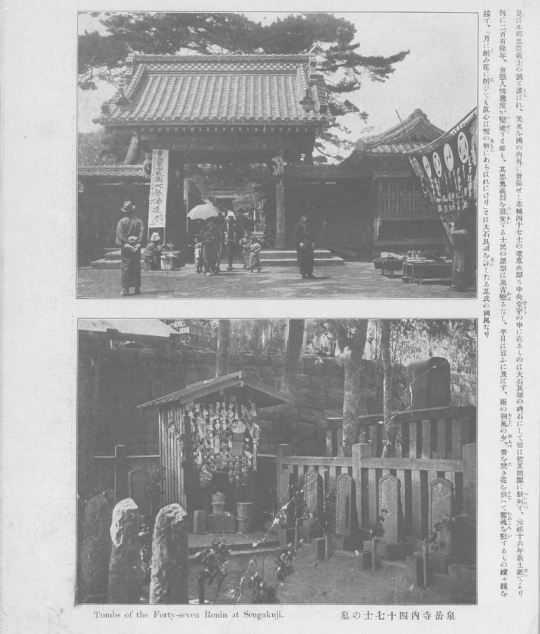
For over a year Ōishi and other retainers lived in apparent retirement. Ōishi passed much time in the leisure quarters of Kyōto, leading so dissolute a life that Kira’s spies were convinced that he entertained no thought of revenge. In the autumn of 1702 Ōishi decided to strike. He and 46 other rōnin, including his son, gathered in Edo. On the night of January 30, 1703, they attacked Kira’s mansion, forced their way in, and killed their hated adversary. That night they offered up his head at Asano’s grave. When the shogun learned of the vendetta, he was sympathetically disposed to Ōishi but finally decided that the 47 rōnin could not be allowed to take the law into their own hands. They were accordingly ordered to disembowel themselves on March 20, 1703.
The incident created an immense stir in Japan. The samurai virtues, seemingly forgotten during long years of peace, asserted themselves again. Innumerable poems and essays described the vendetta, and by 1844 no fewer than 47 plays had been written about the rōnin. Of these the greatest was Chūshingura (1748), an 11-act kabuki drama cycle adapted from the bunraku play by Takeda Izumo with Namiki Sōsuke (Senryū) and Miyoshi Shōraku. The popularity of this work has never flagged, and it served to inspire numerous modern plays, most prominently an adaptation by Mayama Seika. Cinematic treatments included director Mizoguchi Kenji’s Genroku Chūshingura (1941; The 47 Ronin); Ichikawa Kon’s Shijūshichinin no shikaku (1994), which cast Japanese film legend Ken Takakura in the role of Ōishi; and the Hollywood-produced 47 Ronin (2013), a special effects-driven fantasy starring Keanu Reeves that bore only a passing resemblance to the historical source material
The Editors of Encyclopaedia Britannica
This article was most recently revised and updated by Michael Ray.
0 notes
Photo
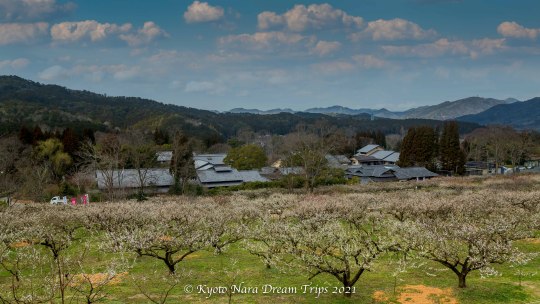
White plum blossoms in the meadow of "Sunai no Sato" grounds in Ōishi Ryumon village Otsu City Shiga Prefecture.
#Chūshingura#Japan#Jōshū Hakubai#Kanō Shōjuan#Landscape#Plum blossoms#Shiga Prefecture#Sunai no Sato#Ume#Winter#matsuri#Ōishi Kuranosuke#叶匠寿庵#城州白梅#大石内蔵助#寿長生の郷#忠臣蔵 梅まつり#梅花#滋賀県
19 notes
·
View notes
Photo
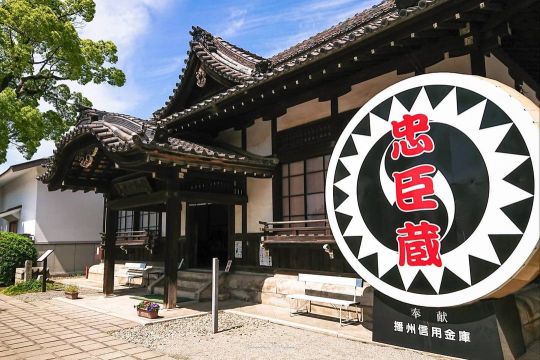
四十七士を偲んで 1枚目、義士宝物殿 2枚目、大石神社義芳門(正門) 3枚目、大石神社本殿(参道より) ※以前に撮影した写真です。 #四十七士 #討ち入り #忠臣蔵 #赤穂浪士 #大石神社 #大石内蔵助 #兵庫県 #赤穂市 #Chūshingura #fortysevenrōnin #akocity #Hyogoprefecture #OishiShrine #xperia https://www.instagram.com/p/CIxTM63g9LN/?igshid=1ko38dwcylhgd
#四十七士#討ち入り#忠臣蔵#赤穂浪士#大石神社#大石内蔵助#兵庫県#赤穂市#chūshingura#fortysevenrōnin#akocity#hyogoprefecture#oishishrine#xperia
1 note
·
View note
Photo

#Manhattan#Woody Allen#Alexander Dovzhenko#Hiroshi Inagaki#Chūshingura: Hana no Maki Yuki no Maki#Chūshingura
3 notes
·
View notes
Photo

Twelfth Act, Tsukioka Yoshitoshi, 1860, 5th lunar month, Minneapolis Institute of Art: Japanese and Korean Art
two standing men at center; both men wear outer garments in bold black and white triangle print with purple blouses; man at left wears pink flowered pants; man at right wears yellow and green flowered pants; two seated men in LLC--man wearing similar black and white garment holding a white and yellow cylindrical object, and bald man seen from back wearing orange; water in background with boats; snow-covered ground and trees around figures Actors Kitaoka Nizaemon VIII as Ōboshi Yuranosuke (R) and Kataoka Gadō II as Ōboshi Rikiya (L). Related to the play Kanadehon Chūshingura 仮名手本忠臣蔵, performed at the Nakamura Theater in the 4th month of 1860.
Size: 6 5/16 × 9 3/16 in. (16.03 × 23.34 cm) (image, sheet, horizontal chūban)
Medium: Woodblock print (nishiki-e); ink and color on paper
https://collections.artsmia.org/art/127753/
36 notes
·
View notes
Photo
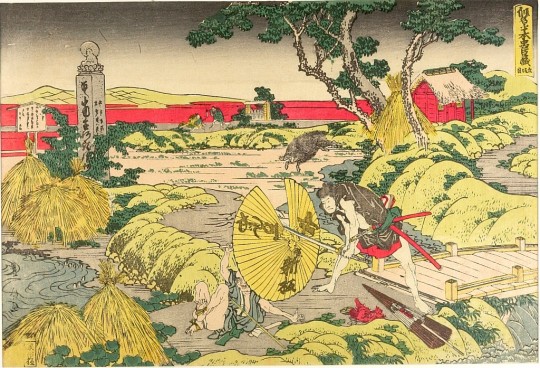
Act V (Godanme), from the series The Storehouse of Loyal Retainers, a Primer (Kanadehon Chūshingura), Katsushika Hokusai, Harvard Art Museums: Prints
Harvard Art Museums/Arthur M. Sackler Museum, Gift of the Friends of Arthur B. Duel
Medium: Ink on paper
https://www.harvardartmuseums.org/collections/object/206724
116 notes
·
View notes
Note
Are you familiar with the play chūshingura? A character (Okaru) sells herself to an okiya in Gion, which is not named but is basically next to the Ichiriki. She wears her obi tied in front, and it's implied she's selling sex, or at least willing to resort to it. Did geisha dress almost exactly like shinzo back in 1702-3, or is she a fancy prostitute or courtesan working in Gion? This happens in act VII btw. Thanks in advance and feliz año nuevo!
In 1702/1703 the geisha profession was in its infancy, so the rule of tying one's obi in the back didn't exist yet ^^
11 notes
·
View notes
Photo

Nakamura Nakazō I as Ono Sadakurō in Kanadehon Chūshingura (Model for Kana Calligraphy: Treasury of the Forty-Seven Loyal Retainers), Katsukawa Shunsho, 1771, Art Institute of Chicago: Asian Art
Clarence Buckingham Collection
Size: 45.5 x 32.8 cm (18 x 12 15/16 in.)
Medium: Color woodblock print; bai aiban
https://www.artic.edu/artworks/110729/
12 notes
·
View notes